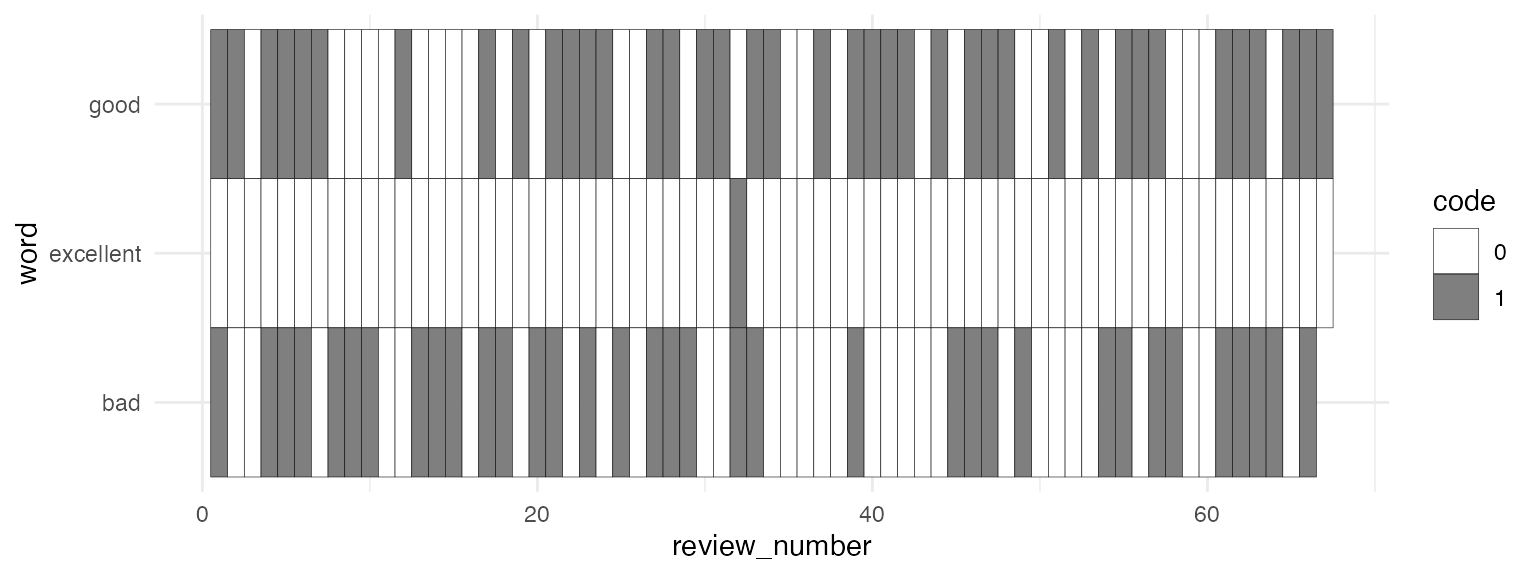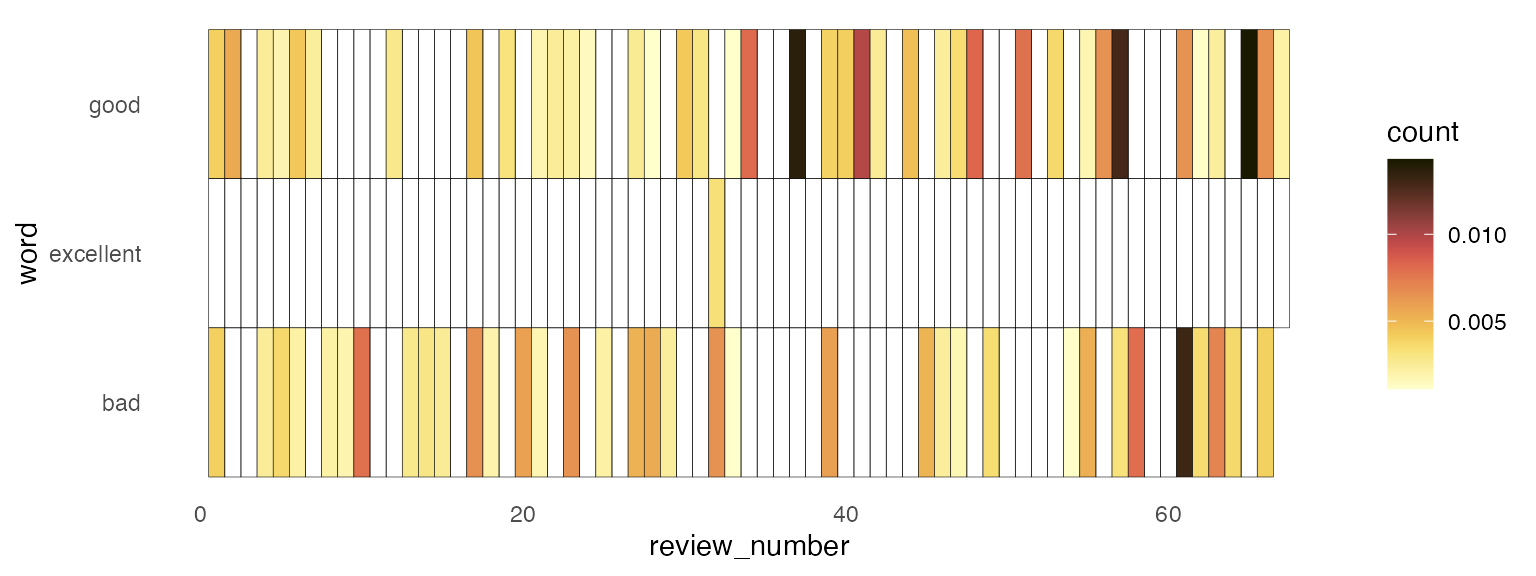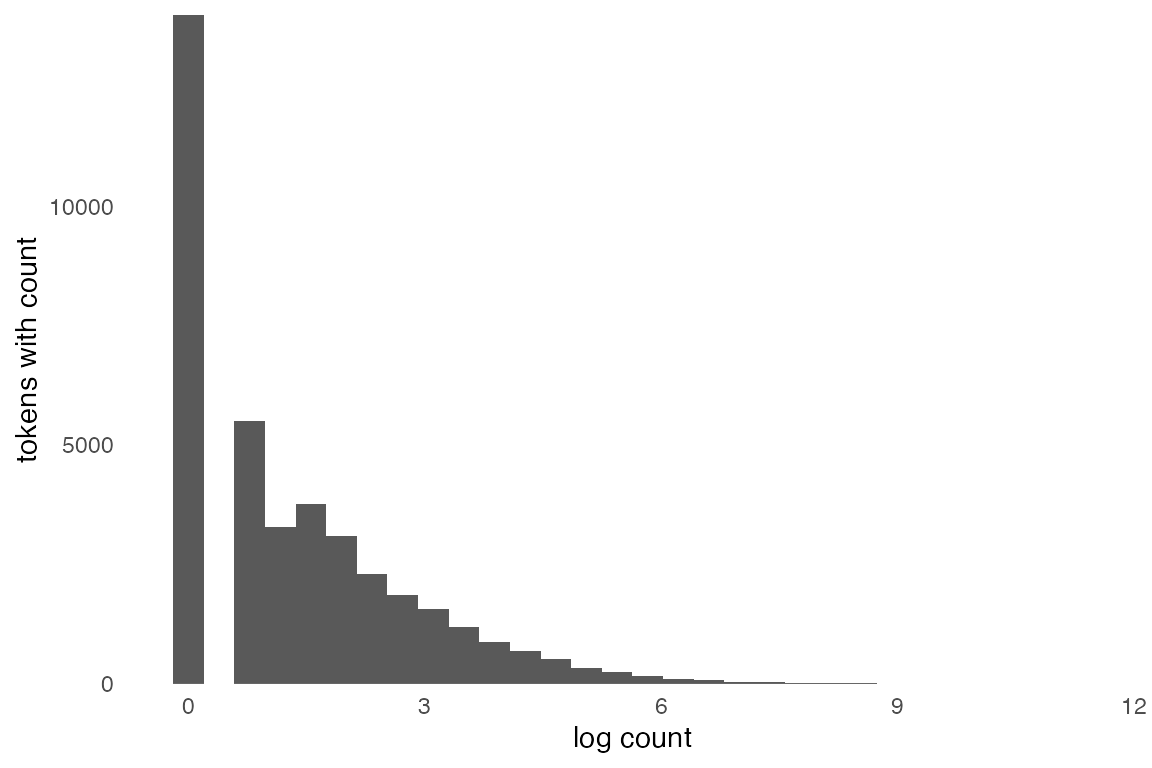Term Frequency - Inverse Document Frequency
Descrbing a document by its words
Binary coding
One way to represent the content of a document, like a movie review, is with a binary code of 1, if a word appears in it, or a 0, if a word does not.
python
import numpy as np
import nltk
from nltk.corpus import movie_reviews
from nltk.corpus import stopwords
all_ids = movie_reviews.fileids()
all_words = [movie_reviews.words(id) for id in all_ids]python
english_stop = stopwords.words("english")
print(english_stop[0:10])['i', 'me', 'my', 'myself', 'we', 'our', 'ours', 'ourselves', 'you', "you're"]python
all_words_filtered = [
[
word
for word in review
if word not in english_stop
]
for review in all_words
]python
review_has_good = np.array([
1
if "good" in review
else
0
for review in all_words_filtered
])
review_has_excellent = np.array([
1
if "excellent" in review
else
0
for review in all_words_filtered
])
review_has_bad = np.array([
1
if "bad" in review
else
0
for review in all_words_filtered
])
Token Counts
Or, we could count how often each word appeared in a review. Probably if a review has the word “good” in it 6 times, that’s a more important word to the review than one where it appears just once.
python
from collections import Counter
good_count = np.array([
Counter(review)["good"]
for review in all_words_filtered
])
excellent_count = np.array([
Counter(review)["excellent"]
for review in all_words_filtered
])
bad_count = np.array([
Counter(review)["bad"]
for review in all_words_filtered
])Since the reviews are different lengths, we can “normalize” them.
python
total_review = np.array([
len(review)
for review in all_words_filtered
])
good_norm = good_count/total_review
excellent_norm = excellent_count/total_review
bad_norm = bad_count/total_review
Document Frequency
On the other hand, it looks like “good” and “bad” appear in lots of reviews.
python
review_has_good.mean()0.591python
review_has_bad.mean()0.3865Wheras, the word “excellent” doesn’t appear in that many reviews overall.
python
review_has_excellent.mean()0.0725Maybe, when the word “excellent” appears in a review, it should be taken more seriously, since it doesn’t appear in that many.
TF-IDF
- TF
-
Term Frequency
- IDF
-
Inverse Document Frequency
The TF-IDF value tries to describe the words that appear in a document by how important they are to that document.
| If a word appears __ in this document | that appears in documents __ | then… |
|---|---|---|
| often | rarely | it’s probably important |
| often | very often | it might not be that important |
Term Frequency
\[ tf = \log C(w)+1 \]
Why log?


python
good_tf = np.log(good_count+1)
excellent_tf = np.log(excellent_count + 1)
bad_tf = np.log(bad_count + 1)Inverse Document Frequency
If \(n\) is the total number of documents there are, and \(df\) is the number of documents a word appears in
\[ idf = \log \frac{n}{df} \]
python
n_documents = len(all_words_filtered)
good_idf = np.log(
n_documents/review_has_good.sum()
)
excellent_idf = np.log(
n_documents/review_has_excellent.sum()
)
bad_idf = np.log(
n_documents/review_has_bad.sum()
)TF-IDF
We just multiply these two together
python
good_tf_idf = good_tf * good_idf
excellent_tf_idf = excellent_tf * excellent_idf
bad_tf_idf = bad_tf * bad_idf
Document “vectors”
Another way to look at these reviews is as “vectors”, or rows of numbers, that exist along the “good” axis, or the “bad” axis.

Doing it with sklearn
python
from sklearn.linear_model import LogisticRegression
from sklearn.model_selection import train_test_split
from sklearn.feature_extraction.text import TfidfVectorizerSetting up the data.
python
raw_reviews = [
movie_reviews.raw(id)
for id in all_ids
]
labels = [
id.split("/")[0]
for id in all_ids
]
binary = np.array([
1
if label == "pos"
else
0
for label in labels
])Test-train split
python
X_train, X_test, y_train, y_test = train_test_split(
raw_reviews,
binary,
train_size = 0.8
)Making the tf-idf “vectorizor”
python
vectorizor = TfidfVectorizer(stop_words="english")
X_train_vec = vectorizor.fit_transform(X_train)
X_test_vec = vectorizor.transform(X_test)Fitting a logistic regression
python
model = LogisticRegression(penalty = "l2")
model.fit(X_train_vec, y_train)LogisticRegression()In a Jupyter environment, please rerun this cell to show the HTML representation or trust the notebook.
On GitHub, the HTML representation is unable to render, please try loading this page with nbviewer.org.
LogisticRegression()
Testing the logistic regression
python
preds = model.predict(X_test_vec)Accuracy
python
(preds == y_test).mean()0.8425Recall
python
recall_array = np.array([
pred
for pred, label in zip(preds,y_test)
if label == 1
])
recall_array.mean()0.86Precision
python
precision_array = np.array([
label
for pred, label in zip(preds, y_test)
if pred == 1
])
precision_array.mean()0.8309178743961353F score
python
precision = precision_array.mean()
recall = recall_array.mean()
2 * ((precision * recall)/(precision + recall))0.8452088452088452python
tokens = vectorizor.get_feature_names_out()
tokens[model.coef_.argmax()]'life'Reuse
Citation
@online{fruehwald2024,
author = {Fruehwald, Josef},
title = {Term {Frequency} - {Inverse} {Document} {Frequency}},
date = {2024-04-02},
url = {https://lin511-2024.github.io/notes/meetings/12_tf-idf.html},
langid = {en}
}